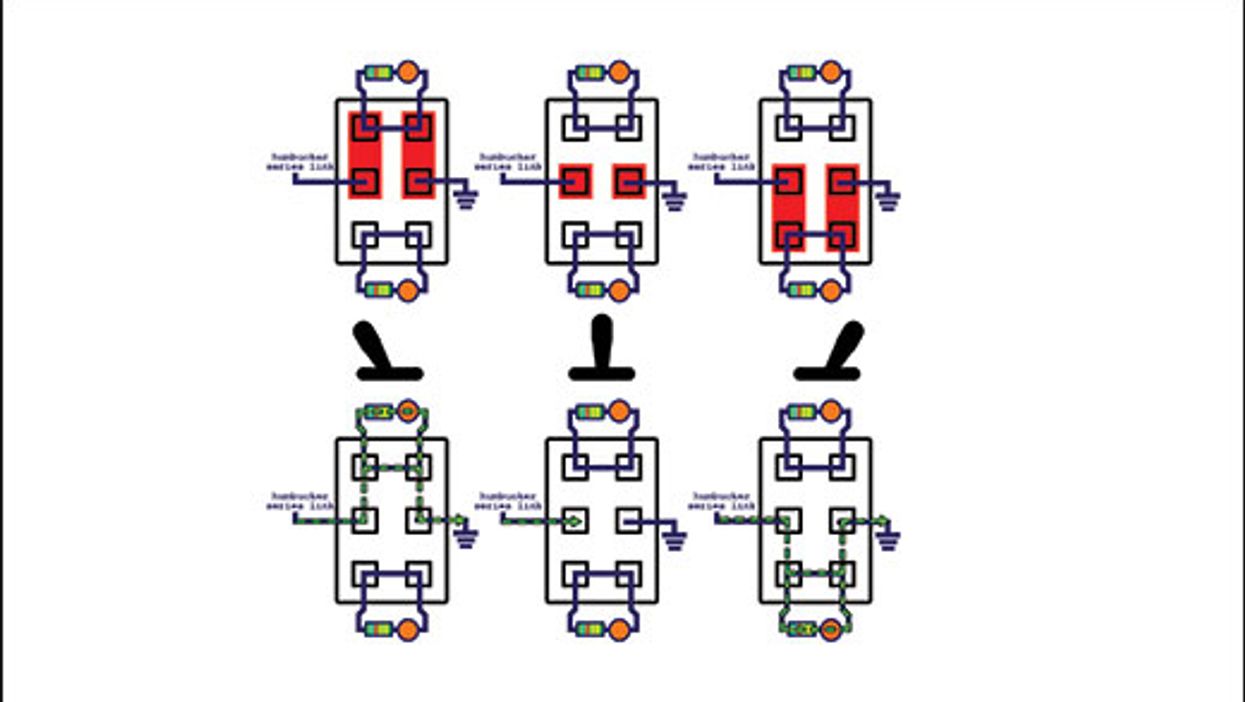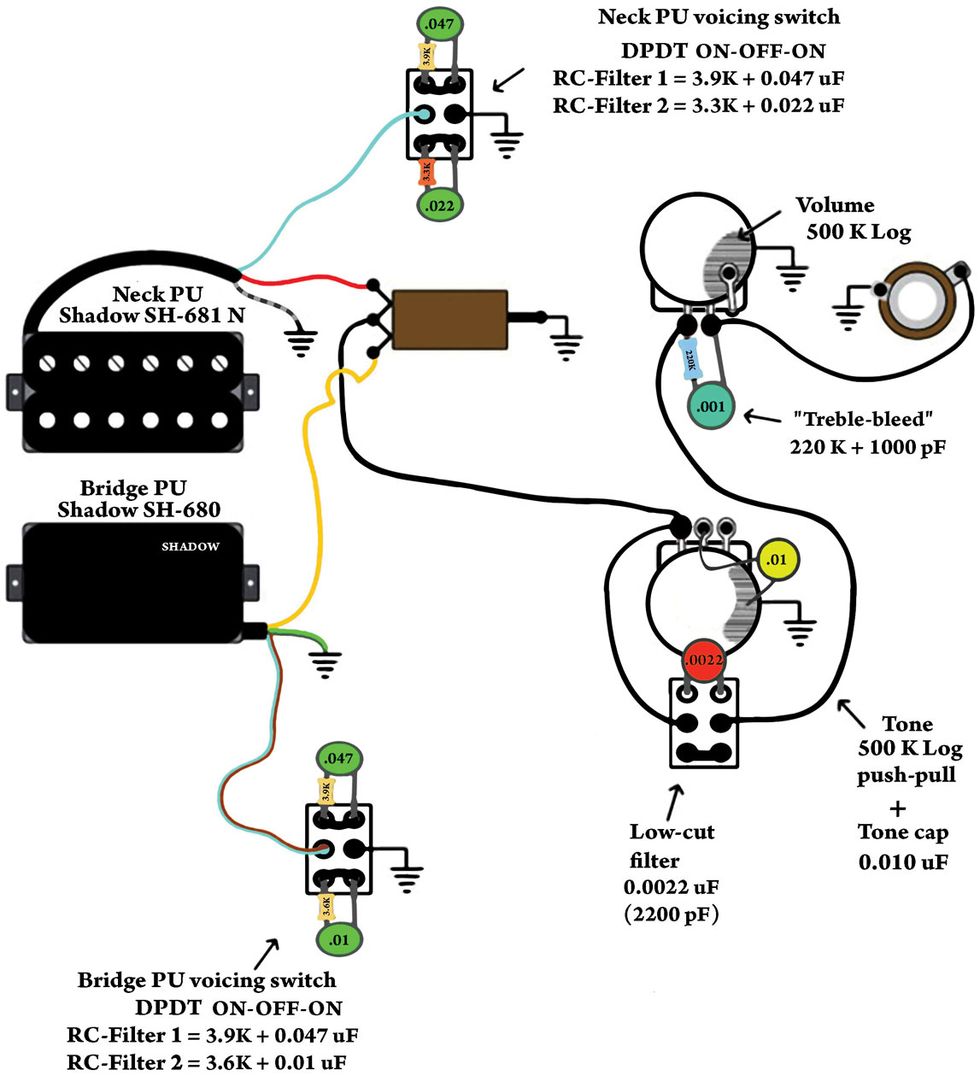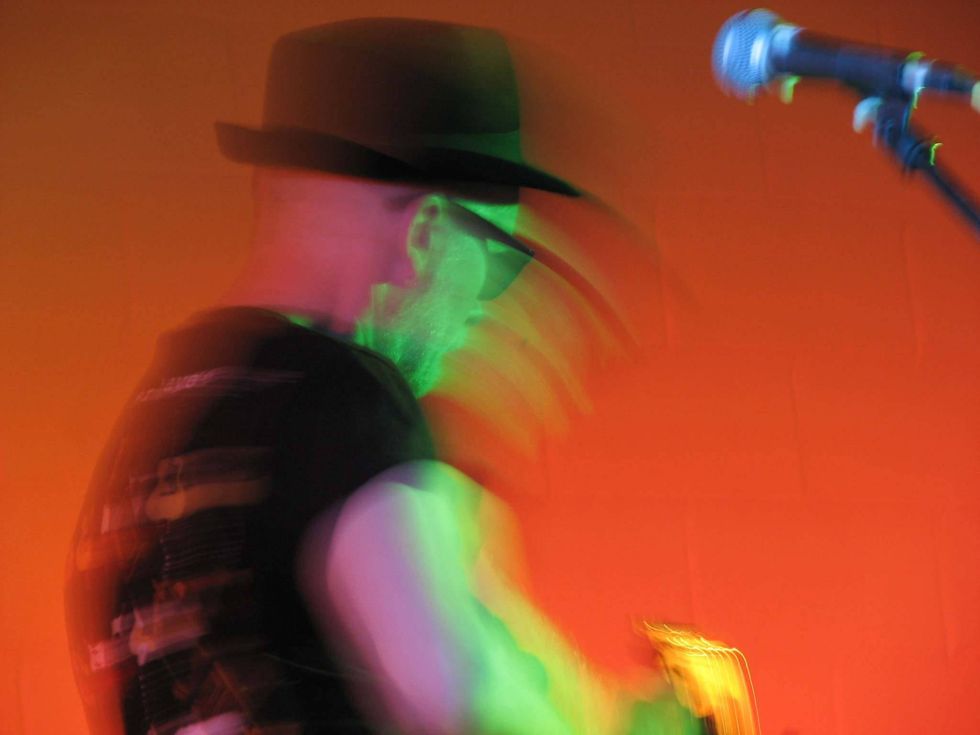You know how life sometimes takes an unexpected twist or turn? I often get emails from PG readers about past columns, and recently I received one from Alexander Mantush, a professional guitarist in Minsk, the beautiful capital of Belarus. He liked my column “The Sound of Silence" and decided to customize this HH wiring to make it even more flexible for his recording projects. Using concepts from my column as a foundation, he came up with the idea of adding a “voicing switch" for each humbucker.
It's not unusual for folks to send me their home-brewed wirings, but this one really caught my eye. Not only did Alexander write a description of the wiring and how it works, he also linked to sound samples of each switching position and included drawings of what he'd done. Here's where the intriguing twist comes into play: On that very day Alexander emailed me, I had a customer's dual-humbucker guitar on the workbench. The owner wanted to make the guitar more silent in split mode, so I was planning to add the hum cancellation from my aforementioned column. Instead, I decided to take a chance and try out Alexander's wiring on this guitar (of course, only after clearing this with the owner beforehand).
It turned out the wiring was fantastic and I want to share it with you now. Alexander calls it the “May wiring" after the local guitar shop in Minsk that did the wiring for him—May GH.
Overview. This wiring scheme is for a dual-humbucker guitar with master volume and master tone, and the latter has a push-pull pot to engage a low-cut filter. It requires humbuckers with 4-conductor wiring. Each pickup has an additional on/off/on toggle switch that's configured to yield different voicings in the upper and lower switching positions, as well as bypass in the middle position.
Here's how Alexander describes it:
The neck pickup voicing switch features two parallel RC filters. One consists of a 3.9k resistor plus a 0.047 µF capacitor, and the other has a 3.3k resistor plus a 0.022 µF capacitor. The two parallel RC filters on the bridge pickup's voicing switch comprise a 3.9k resistor plus a 0.047 µF capacitor and a 3.6k resistor plus a 0.010 µF capacitor.
I've chosen DPDT on/off/on switches because the tap (humbucker series-link) is disconnected in the middle position (only poles 2 and 5 are engaged and both disconnected from each other). In the toggle's upper position, the tap goes through a jumper connection to the switch's second side with parallel RC filter #1 to ground (poles 1, 2, 4, and 5 are active). The same thing happens in the toggle's lower position, but with RC filter #2 (poles 2, 3, 6, and 5 are active).
The cool thing about this wiring is that it helps avoid ground loops by isolating ground from the inactive filter.
The tones. The neck pickup with activated tap and the 3.9k plus 0.047 µF RC filter sounds similar to a standard Strat pickup—not a 100 percent Strat sound, but very close. The 3.3k plus 0.022 µF RC filter yields a tone I'd describe as “Tele neck pickup meets P-90." With a typical clean amp setting, the difference between the two filters lies mainly in the midrange frequencies. Adding overdrive shows faster attack with the 3.9k plus 0.047 µF filter and a somewhat “hollow" midrange response with the 3.3k plus 0.022 µF filter.
Because the bridge pickup is a modern-voiced, high-output humbucker, its switch has a different philosophy behind it. With the coil-tap activated, the 3.9k plus 0.047 µF filter delivers a “gold-foil" voicing, while the 3.6k plus 0.010 µF filter sounds closer to a Telecaster, in my opinion.
Image 2 — Diagram courtesy Alexander Mantush
But the fun really starts when you engage both pickups and activate the coil-tap: Here the sound falls right between a Stratocaster's bridge-plus-middle-pickup cluck and a Telecaster's bridge-plus-neck tone. Choosing different filters with both pickups engaged delivers various midrange flavors, moving from a low-midrange scoop to higher-midrange scoop.
Wait—there's more. Another mod from my wiring is a low-cut 2200 pF capacitor that's connected to the master tone push-pull pot. Its job is to thin out the sound of the pickup's tone by removing the very low end. Providing just enough bass cut, a 2200 pF cap is especially useful with both humbuckers on. It can also help make the neck pickup sound as if it's located closer to the bridge. In dual-pickup mode with the coil-tap on, the low-cut filter can emulate the sound of strumming “wacka wacka" rhythms through a wah.
Okay, here are Alexander's diagrams: Image 1 illustrates the matrix for the voicing switches and Image 2 shows the complete wiring. As reflected in the diagram, Alexander's guitar is loaded with two Shadow pickups, so when wiring another brand of humbuckers, you'll need to convert the wire colors using one of the pickup color-code charts that are available online.
Here is a complete list of this wiring's 15 possible settings. As a bonus, you have the option to engage the low-cut filter for each one, which effectively doubles the switchable tones.
• Bridge full
• Bridge with RC filter 1
• Bridge with RC filter 2
• Neck full
• Neck with RC filter 1
• Neck with RC filter 2
• Bridge full + neck full
• Bridge with RC filter 1 + neck full
• Bridge with RC filter 2 + neck full
• Bridge full + neck with RC filter 1
• Bridge full + neck with RC filter 2
• Bridge with RC filter 1 + neck with RC filter 1
• Bridge with RC filter 2 + neck with RC filter 2
• Bridge with RC filter 1 + neck with RC filter 2
• Bridge with RC filter 2 + neck with RC filter 1
And that's it. Next time we'll learn how to shield a humbucker cover so you don't lose the pickup's high-end sparkle. Until then, keep on modding!












![Rig Rundown: Russian Circles’ Mike Sullivan [2025]](https://www.premierguitar.com/media-library/youtube.jpg?id=62303631&width=1245&height=700&quality=70&coordinates=0%2C0%2C0%2C0)








